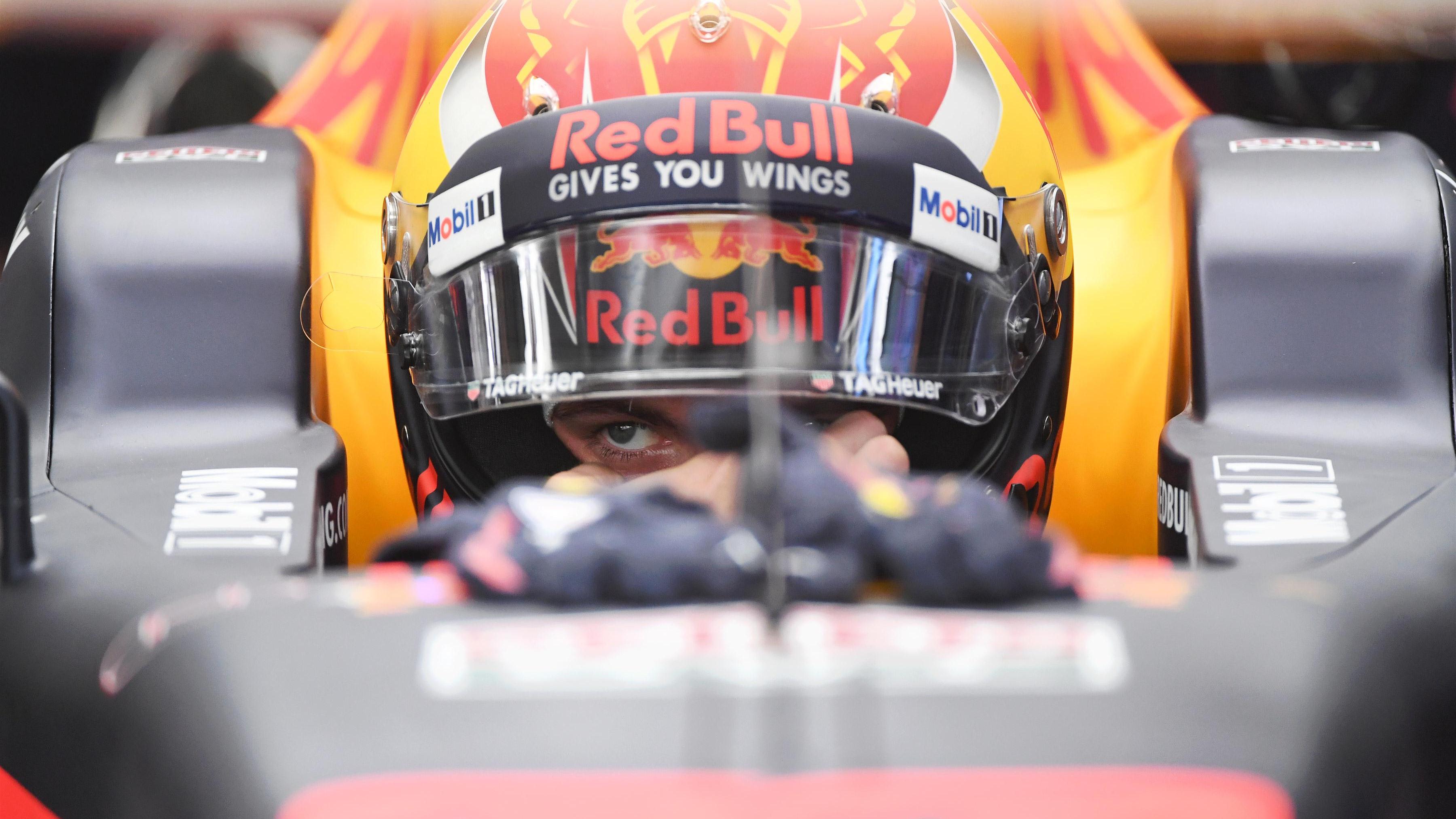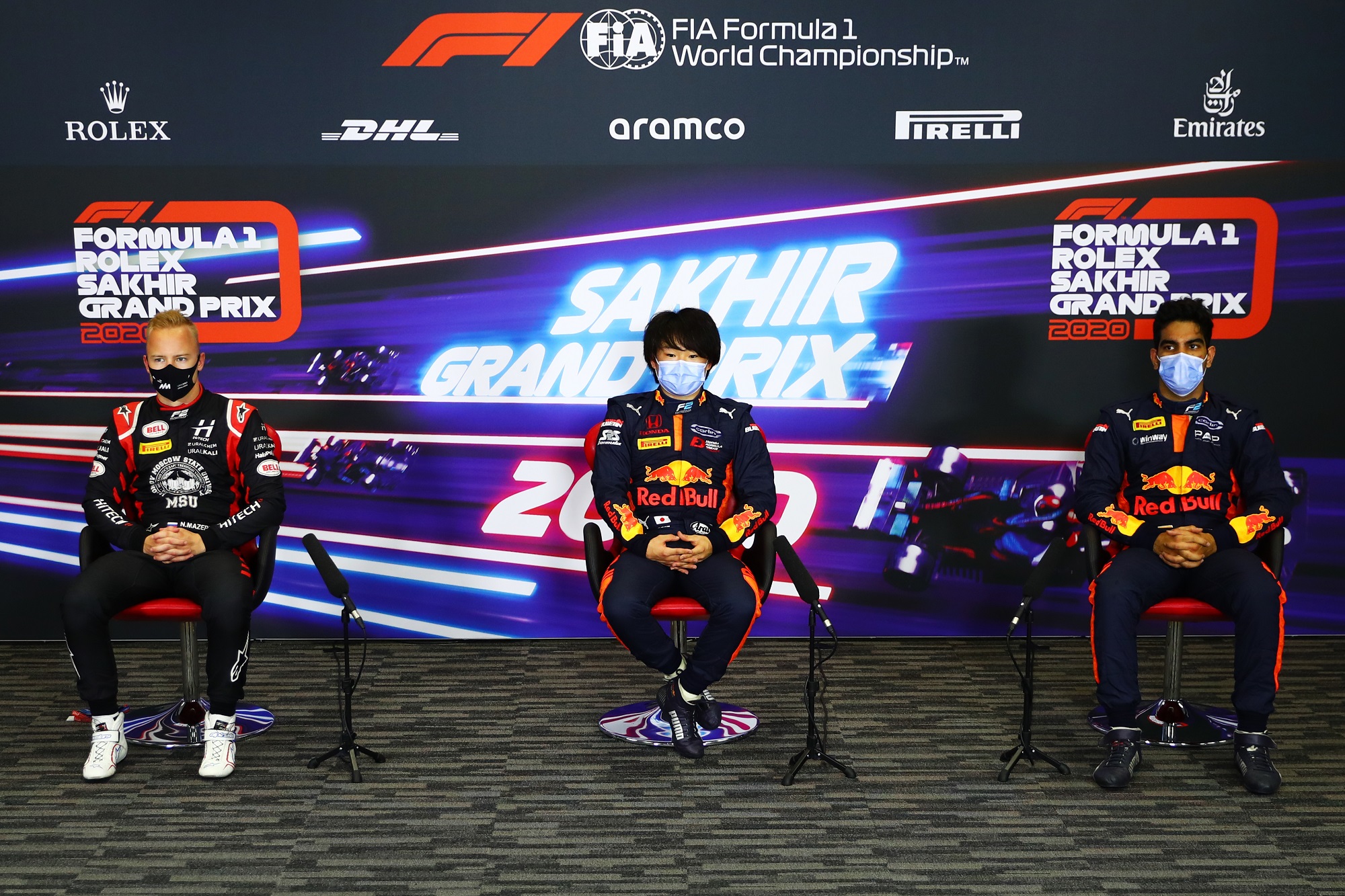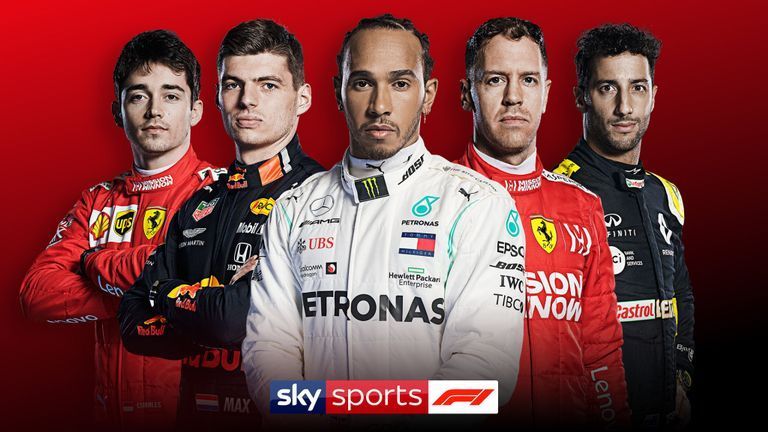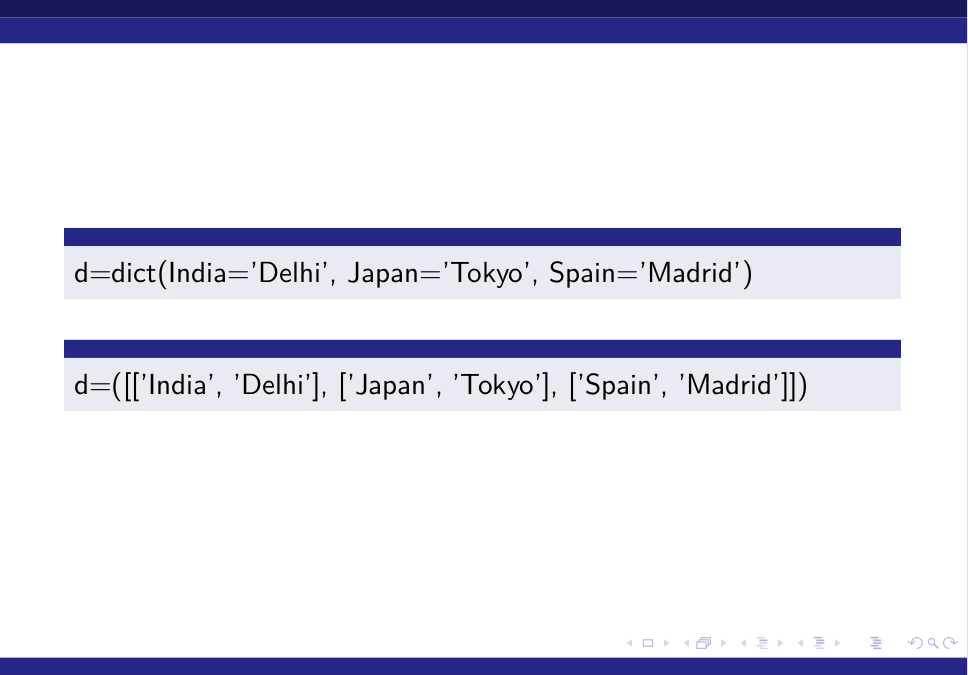Dirty Air — The disturbed air left behind an F1 car, which negatively affects the aerodynamics of the following car.Downforce — The aerodynamic force that is applied in a downwards direction as a car travels forwards. This is harnessed to improve a car's traction and its handling through corners. Modern F1 cars produce enough downforce that they could drive upside-down on the ceiling. A moveable rear wing component that, when opened, reduces drag permitting higher straight-line speed. For years adjustable bodywork was banned in F1 until DRS was introduced in 2011 as a technology for increasing overtaking. Drivers must enter the pit lane, drive through it complying with the speed limit, and re-join the race without stopping.
A more rare but harsher penalty is the stop-and-go, where a driver must remain stationary for 10 seconds at the head of pit lane, without changing tires or other work being performed on his car. (Can you tell what this author thinks of F1 officiating?) In practical terms, a drive-through penalty almost, but not always, guarantees loss of position, as the field continues at race speed. Endplate — The vertical panels that form the outer edges of a car's front and rear wings and to which the main wing elements are attached.
After a few laps the computer has a good idea of the shape of the track. From that baseline the ECU builds up a memory of what the engine has to do at each point of the circuit to maintain peak efficiency. In this way, the engine can "learn" the circuit and the engine settings can be "mapped" for all operating conditions to produce maximum power. Changes in engine mapping duringparc fermé conditions — such as between qualifying and a GP race start — were banned by the FIA in 2011 and again in 2012.ECU — Electronic Control Unit. The computer that controls, among other things, the performance of an F1 car's engine.
ECUs are collectively supplied by FIA in order to limit the teams' use of software technology to gain a performance advantage. The ECU monitors all aspects of the power train and gathers data from 150 to 300 sensors located on each car. Box — F1 parlance for "pit." Also used as a verb, as in the common "box this lap" and "box, box, box" radio directives to Formula One drivers. Under normal operation about 60% of braking power goes to the front wheels which, because of load transfer under deceleration, take the brunt of the retardation duties. Electronic braking is used to offset the effect of the power unit's Energy Recovery Systems by aiding the braking effort at the rear, negating the need for the driver to constantly alter the brake bias. Teams adjust camber to improve a car's handling characteristics.
The tire's relationship with the road changes as the suspension moves through its travel. Ideally, car designers want a camber curve that keeps the tire straight up and down when the car is driven straight, and leans the tire in slightly during cornering. Camber allows the weight of the car lean on the outer, more loaded tires, providing additional contact in a corner. When done well, this virtual testing allows engineers to simulate, with a relatively high degree of accuracy, how many components of a car will perform. Like a wind tunnel but using supercomputer simulations, CFD has now become routine in Formula One.Chassis — The main component of a car that everything else is attached to. The principal structural part of a racing car to which the engine and suspension are mounted is called the chassis.
The chassis provides the rigidity and strength that holds the car together and also protects the driver. Usually inserted into a circuit to slow the cars, often just before what had been a high-speed corner. S-Ducts were invented by Sauber in 2012 but were later adopted by larger teams and became increasingly popular in 2015.Safety Car — This is used instead of a red flag when the stewards wish to slow down the race due to safety reasons or weather. Under the safety car, the cars continue to move in their racing order and when the track is safe again they have a rolling start.
These sections are officially known as Sector 1, Sector 2 and Sector 3.Set Up — Tuning a car's suspension, tire pressure, camber, wings, ride height and related components and settings to achieve the correct balance, grip and speed for a circuit. Car set up is worked on in practice and qualifying, after which parc fermé conditions apply and mechanics cannot adjust set up until the race is started. An engine may be very powerful, but if it has little torque that power may only be available over a limited rev range, making it of limited use to the driver. An engine with more torque — even if it has less power — may actually prove quicker on many circuits, as power is available over a far wider rev range and hence more accessible. If either of a car's driven wheels is losing traction, i.e., spinning, the system transfers more drive to the wheel with more traction, thus using engine power more efficiently.
Along with pre-programmed automatic gearbox sequences, it is sometimes called 'launch control" because it eliminates wheelspin at the start of the race. VSC is signaled on the trackside light panels but the safety car is not actually deployed. FIA also decreed that the start times for the Australian and several Asian GPs would be moved an hour earlier to ensure maximum sunlight throughout each race. Racing drivers strive to keep the car "at the limit" in order to achieve the fastest possible lap times. The crew member holding the lollipop was known, appropriately, as the "lollipop man" — often the target of criticism if a car was released into pit lane too soon. MGU-K (for "kinetic") generates power by harvesting kinetic created during braking; MGU-H (for "heat") is connected to the turbocharger of the engine ad generates power by converting heat from exhaust gases into electricity.
All that energy its stored in a battery located at the bottom of the F1 car chassis. Together, the NGUs provide an additional 160bhp for the power units.Marbles — Small bits of rubber thrown off by racing tires as they degrade over the course of a stint, typically found on the outside of corners off the racing line. Also known as "grains." Moving offline is thus termed going "into the marbles," and typically results in a reduction in traction, oversteer and a more difficult to control, slower race car. Drivers will collect marbles after a race by steering their car's hot tires over the dirty part of the track in order to increase the car's weight to ensure the car meets the minimum weight requirement.
Balaclava — A mandatory cloth head covering made of fire-retardant material won underneath drivers' helmets in order to improve protection in case the car catches fire. If a car is set up for fast straights, using low downforce settings, for instance, it will tend to be slower in corners due to a relative lack of grip, and conversely. Their shape and size are influenced by the F1 technical regulations and aerodynamic design, with current rules all but eliminating bargeboards in favor of sleek, high-nosed designs that funnel airflow under the car.
Options — The former designation of softer tires — as opposed to harder, or "prime" tires — indicated by a colored line or lettering on the sidewall. Current Pirelli compounds typically include soft, super soft and ultra soft compounds. Oversteer often requires opposite-lock to correct, whereby the driver turns the front wheels into the skid.
No team members are allowed to touch cars in parc fermé except under the supervision of race stewards. Yet despite these changes, constructors continued to extract performance gains by increasing power and aerodynamic efficiency. As a result, the pole position speed at many circuits in comparable weather conditions dropped between 1.5 and 3 seconds in 2004 over the prior year's times. The aerodynamic restrictions introduced in 2005 were meant to reduce downforce by about 30%, however, most teams were able to successfully reduce this to a mere 5 to 10% downforce loss. In 2006 the engine power was reduced from 710 to 560 kW by shifting from the 3.0L V10s, used for a decade, to 2.4L V8s. Some of these new engines were capable of achieving 20,000 rpm during 2006, though for the 2007 season engine development was frozen and the FIA limited all engines to 19,000 rpm to increase reliability and control at increasing engine speeds.
Pit Board — A board held out on the pit wall to inform a driver of his race position, the time interval to the car ahead or the one behind and the number of laps remaining. Pit boards are still used, although most communication between team and driver takes place by radio today.Pit Lane – A separate part of the track where work can be done on the car by the crew. A maximum speed limit on pit lane is now enforced to ensure mechanics' and other people's safety. A violation of this speed limit results in a ten-second penalty, a fine for the team, or both.
In F1, team garages are located immediately behind each pit station. The pit lane is known as "pit road" or "pit row" in American NASCAR and IndyCar racing.Pit Stop — A procedure carried out during a race to change tires, add fuel and in some cases repair damage. The radical new technical regulations introduced for the 2014 F1 season saw the debut of a new power unit consisting of a 1.6-liter V6 turbo engine and two Energy Recovery Systems. The 2.4-liter normally-aspirated V8 engines of 2013 produced around 750bhp, with an additional 80 bhp available for around 6s per lap from KERS.
However, two new ERS systems — MGU-K and MGU-H — give drivers an additional 160 bhp or so for approximately 33s per lap, compared to 6s earlier. MGU-H generates electricity back into the car's battery using exhaust fumes, which also keep the turbos spinning at 120,000 RPM to eliminate turbo lag. The major difference being that the latter was driver initiated with a steering wheel button, while the new units kick in automatically via the throttle. See KERS.FIA — Fédération International de l'Automobile, the sanctioning body responsible for establishing and enforcing both the sporting and technical regulations governing the Formula One World Championship series. Its predecessor was the Fédération Internationale du Sport Automobile , at the time an autonomous subcommittee of the FIA. F-ducts were first introduced by McLaren and were promptly banned for 2011, replaced with DRS.They represent a classic case of race engineers finding ways around the FIA technical regulations to gain an advantage.
F-ducts resulted in ugly car designs featuring high spines running all the way from the air intake to the rear wing. F1 designers like Adrian Newey and John Barnard have achieved particular notoriety in the past several decades.Diffuser — The rear section of the car's floor or undertray where the air flowing under the car exits. The design of the diffuser is crucial as it controls the speed at which the air exits. The faster its exit, the lower the air pressure beneath the car, and hence the more aerodynamic downforce the car generates. Diffuser design includes vertical fences, some of which are curved, some stepped and some angled, but all are developed through constant tweaking and evolution in the wind tunnel.
In 2009, Brawn GP and later other F1 teams exploited rule loopholes to create additional underbody inlets feeding larger exit areas, known as the "double diffuser," now outlawed of course. Halo — A cockpit protection system, criticized by many as ugly, senseless or both, introduced by FIA for the 2018 F1 season to give added safety against flying objects, tires, etc., impacting the driver's helmet. The Halo is an integral part of the chassis and able to withstand loads of some three tons.Headrest — The removable energy-absorbing foam that surrounds the driver's helmet in the cockpit.
Three different grades of foam are used, depending on the ambient temperature.HANS — The Head and Neck Support System, a black collar that fits over the driver's shoulders and attaches to the helmet. Straps restrict forward movement of the head in an accident, reducing the risk of cervical injury.Heat Cycle — A term used to describe the process by which a tire is heated through use and then cooled down. This has the effect of slightly changing the properties of the compound and can improve durability.Hot Lap — A lap where a driver pushes at 100 percent to set his fast possible time, typically used to describe qualifying laps. Often employed by drivers as a tactical measure to gain a competitive advantage when rain is just beginning in a race, "inters" risk significantly slowing the car's pace if the track remains dry. Intermediate and wet racing tires both degrade very rapidly in dry circuit conditions.
Tires that use softer rubber, for example, will not last as long as medium or hard tires under race conditions but will provide the best grip, resulting in faster lap times but possibly more pit stops. Tire choice is important for determining the pit stop strategy of a car. Tire barriers are stacks of used tires bundled together and wrapped, usually colored read and white, that absorb the energy of a crash and thus lessen damage and injury.
Before tire barriers and Armco, Grand Prix races used hay bales to guard dangerous corners.Tire Degradation — As tires wear and lose rubber, reducing grip, the process is known as tire degradation, typically more pronounced with soft, option tires. The driver has the ability to fine-tune many elements of the race car from within the machine using the steering wheel. The wheel can be used to change gears, apply rev. limiter, adjust fuel/air mix, change brake pressure, and call the radio.
Data such as engine rpm, lap times, speed, and gear are displayed on an LCD screen. The wheel hub will also incorporate gear change paddles and a row of LED shift lights. The wheel alone can cost about $50,000, and with carbon fibre construction, weighs in at 1.3 kilograms. In the 2014 season, certain teams such as Mercedes have chosen to use larger LCDs on their wheels which allow the driver to see additional information such as fuel flow and torque delivery. They are also more customizable owing to the possibility of using much different software. FOTA — The Formula One Teams Association was a loose collection of F1 teams that played a rather tangential role in F1 for decades.
Suffering from the withdrawal of Ferrari and Red Bull, FOTA disbanded formally in 2014.G-Force — A physical force equivalent to one unit of gravity that is multiplied during rapid changes of direction or velocity. Drivers experience severe G-forces as they corner, accelerate and brake.Graining — When a car slides, it can cause little bits or rubber ("grains") to break away from the tire's slick surface. These may then stick to the tire, effectively separating it from the track surface. Careful driving can clear graining within a few laps, but will obviously have an effect on the driver's pace. Driving style, track conditions, car set-up, fuel load and the tire itself all play a role in graining. Revised regulations introduced in 2005 forced the aerodynamicists to be even more ingenious.
In a bid to cut speeds, the FIA reduced downforce by raising the front wing, bringing the rear wing forward, and modifying the rear diffuser profile. The designers quickly regained much of this loss, with a variety of intricate and novel solutions such as the 'horn' winglets first seen on the McLaren MP4-20. Most of those innovations were effectively outlawed under even more stringent aero regulations imposed by the FIA for 2009. The changes were designed to promote overtaking by making it easier for a car to closely follow another. The new rules took the cars into another new era, with lower and wider front wings, taller and narrower rear wings, and generally much 'cleaner' bodywork.
Perhaps the most interesting change, however, was the introduction of 'moveable aerodynamics', with the driver able to make limited adjustments to the front wing from the cockpit during a race. Jump Start — When a driver moves off his grid position before the five red lights have been switched off to signal the start. Sensors detect premature movement and a jump start earns a driver a penalty.KERS — The Kinetic Energy Recovery System, or KERS, became legal from 2009 onwards. KERS recovers waste kinetic energy from the car during braking, storing that energy and then later making it available to propel the car. The driver had access to the additional power for limited periods per lap, via a "boost button" on the steering wheel, until the car's KERS was replenished.
A substantial amount of downforce is provided by using a rear diffuser which rises from the undertray at the rear axle to the actual rear of the bodywork. However, this drag is more than compensated for by the ability to corner at extremely high speed. And for those wondering what we mean by 'aerodynamics', it's the study of the properties of moving air and the interaction between the air and the car, often the defining science in modern F1 design.
Since the 1960s, teams have used downforce-creating wings to push cars into the track to create more grip. The goal is to create more downforce without a corresponding increase in drag. Every surface of the car – including the driver's helmet – influences aerodynamic behaviour.
And a car's set-up, which includes its aerodynamics, is constantly optimised to suit the demands of every circuit. (From 2013 DRS is available only at the pre-determined points during all sessions). The system "stalls" the rear wing by opening a flap, which leaves a 50 mm horizontal gap in the wing, thus massively reducing drag and allowing higher top speeds. However, this also reduces downforce so it is normally used on long straight track sections or sections which do not require high downforce.
The system was introduced to promote more overtaking and is often the reason for overtaking on straights or at the end of straights where overtaking is encouraged in the following corner. However, the reception of the DRS system has differed among drivers, fans, and specialists. Due to increasing environmental pressures from lobby groups and the like, many have called into question the relevance of Formula 1 as an innovating force towards future technological advances .
The FIA has been asked to consider how it can persuade the sport to move down a more environmentally friendly path. Therefore, in addition to the above changes outlined for the 2009 season, teams were invited to construct a KERS device, encompassing certain types of regenerative braking systems to be fitted to the cars in time for the 2009 season. The system aims to reduce the amount of kinetic energy converted to waste heat in braking, converting it instead to a useful form to be later fed back through the engine to create a power boost. However, unlike road car systems that automatically store and release energy, the energy is only released when the driver presses a button and is useful for up to 6.5 seconds, giving an additional 60 kW and 400 kJ. It effectively mimics the 'push to pass' button from IndyCar and A1GP series. KERS was not seen in the 2010 championship – while it was not technically banned, the FOTA collectively agreed not to use it.
It however made a return for the 2011 season, with all teams except HRT, Virgin and Lotus utilizing the device. Modern-day Formula One cars are constructed from composites of carbon fibre and similar ultra-lightweight materials. The minimum weight permissible is 740 kg including the driver but not fuel. Prior to the 2014 F1 season, cars often weighed in under this limit so teams added ballast in order to add weight to the car.




























No comments:
Post a Comment
Note: Only a member of this blog may post a comment.